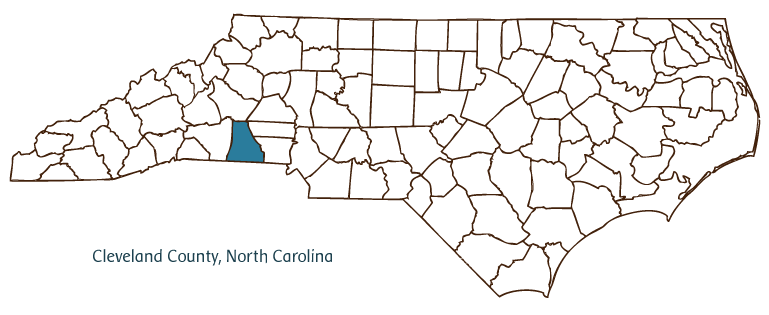Cleveland County Resources
- View All:
- Biographies
- Monuments
- locations
Copyright Notice: This article is from the Encyclopedia of North Carolina edited by William S. Powell. Copyright © 2006 by the University of North Carolina Press. Used by permission of the publisher. For personal use and not for further distribution. Please submit permission requests for other use directly to the publisher.

Cleveland County, located in the Piedmont region of southwestern North Carolina, was formed in 1841 from Rutherford and Lincoln Counties; it was named for Col. Benjamin Cleveland, a hero at the Revolutionary War battle of King's Mountain (7 Oct. 1780). Cleveland County partially borders the state of South Carolina. Early inhabitants of the region included the Cherokee and Catawba Indians, followed by German, Scotch-Irish, English, and French settlers. The county seat, Shelby, was incorporated in 1843 and named for Col. Isaac Shelby, a Revolutionary War commander. Other communities in the county include Belwood, Boiling Springs, Mooresboro, Grover, and Earl. Notable physical features include John H. Moss Lake, Benn Knob, the Broad River, and Buffalo and Suck Creeks.
Just across the South Carolina border from Cleveland County is Kings Mountain National Military Park. Gardner-Webb University in Boiling Springs was established in 1905. The county also spawned the "Shelby Dynasty," a generation of twentieth-century politicians that included Governors O. Max Gardner and Clyde Hoey. Author Thomas Dixon Jr., whose 1905 novel, The Clansman, became the source of the controversial epic film The Birth of a Nation (1915), was a native of Shelby. Cleveland County is home to Rogers' Theatre Block (ca. 1930s) and Shelby City Hall (1939). Cultural and historical institutions include the King's Mountain Fire Museum and the Cleveland County Arts Council. Cleveland County hosts popular annual festivals such as the Ham Fest, the Belwood Antique Tractor and Engine Show, and King's Mountain July Fourth.
Cleveland County agricultural products include soybeans, alfalfa, apples, peaches, cotton, hay, swine, sheep, poultry, and beef and dairy cattle. Manufactured products include textiles, fiberglass, truck cabs, commercial refrigerator systems, and the rescue apparatus known as the "jaws of life." Minerals such as quartz crystal, iron, corundum, beryl, and graphite are also mined in the county. The population of Cleveland County was estimated to be slightly more than 97,000 in 2004.
For an annotated history of the county's formation, with the laws affecting the county, boundary lines and changes, and other origin information, visit these references in The Formation of the North Carolina Counties (Corbitt, 2000), available online at North Carolina Digital Collections (note, there may be additional items of interest for the county not listed here):
County formation history: https://digital.ncdcr.gov/Documents/Detail/the-formation-of-the-north-ca...
Index entry for the county: https://digital.ncdcr.gov/Documents/Detail/the-formation-of-the-north-ca...
Additional resources:
Corbitt, David Leroy. 2000. The formation of the North Carolina counties, 1663-1943. https://digital.ncdcr.gov/Documents/Detail/the-formation-of-the-north-carolina-counties-1663-1943/3692099?item=4553233 (accessed June 20, 2017).
Cleveland County Government: https://www.clevelandcounty.com/
Cleveland County Chamber of Commerce: https://clevelandchamber.org/
DigitalNC, Cleveland County: https://www.digitalnc.org/counties/cleveland-county/
North Carolina Digital Collections (explore by place, time period, format): https://digital.ncdcr.gov
Image credits:
Rudersdorf, Amy. 2010. "NC County Maps." Government & Heritage Library, State Library of North Carolina.
Mazzocchi, Jay. "Cleveland County." NCpedia. State Library of NC. 2006. https://www.ncpedia.org/geography/cleveland.